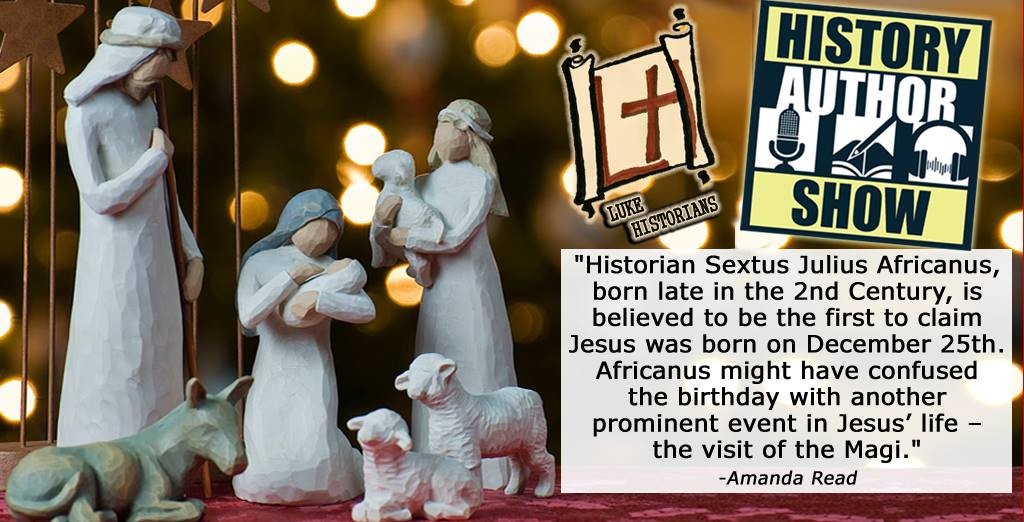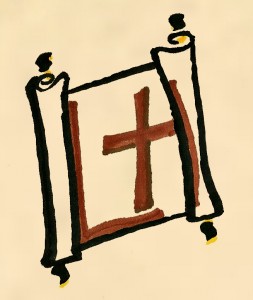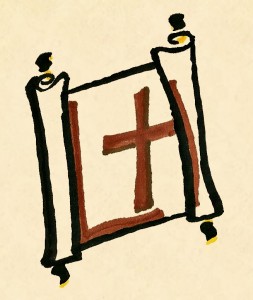As featured on the History Author Show: What does Christ have to do with Christmas Day?

The following article by Amanda Read was originally published in some form at The Washington Times Communities.
Christmas Day is acknowledged and celebrated internationally. But its significance is not widely understood. Many words have been spent to explain, justify, excuse, or debunk the holiday by turns, with frequent arguments hinging upon the fear of tainting Christianity with paganism.
Traditionally, Christmas has been celebrated as the birthday of Jesus Christ, even though many educated people know that a variety of factors indicate that He was not actually born at that time. How did the excitement around December 25th originate, then? Was it a pagan festival later co-opted by intellectually and spiritually lazy Christians for who-knows-what-reason? Does celebration on December 25th originate from nothing more than adaptations of winter solstice festivals?
It would certainly be easy to accept these notions and move on. But history has a goldmine of information beyond that, and it would be a shame to miss out on it this season. This article will be a brief introduction to a sadly forgotten Biblical heritage.
Luke records little details in his volume of the Gospel which indicate when the Messiah entered the world. Luke was a scientific-minded Greek physician who began his record with the story of the Angel Gabriel visiting an elderly Jewish priest. Luke doesn’t describe him as a generic priest, however – but rather specifically as Zacharias of the division of Abijah. This detail is a time-marker, because each priestly division had particular times of the year at which to serve.
It is probable that as part of the eighth priestly division (1 Chronicles 24:10), Zacharias was serving during the month of Sivan (May-June), and since Elizabeth apparently became pregnant with John the Baptist shortly afterward (following Shavuot/Pentecost), we can understand the significance of what Luke wrote next.
When Gabriel told Mary that she would conceive the Messiah as a virgin, he encouraged her with this piece of personal evidence: Elizabeth (her aged and previously barren cousin) was six months along with a baby herself. That means that the Annunciation and Mary’s subsequent conception of Jesus (or Yeshua) likely happened in December.
Thus, the Light of the World became incarnate most likely during the winter Feast of Dedication, also known as Hanukkah or the Festival of Lights. Although Hanukkah was a later Jewish festival that developed outside of the Torah, it has spiritual and political significance for believers and is mentioned in the Gospel (John 10:22).
The conception of Jesus Christ at Christmastime is a hypothesis further supported by the fact that nine months later is when the Feast of Tabernacles (Sukkot/Succoth) would take place. This occurred in autumn, a more reasonable time for the shepherds to be watching their flocks at night in those fields of Bethlehem that were acquired ages beforehand through the romance of Boaz and Ruth (King David’s great-grandparents).
Furthermore, since rabbinical evidence suggests that John the Baptist was born at Passover (Pesach) in the month of Nisan, it follows that Jesus Christ, who was six months younger, would be born six months later in the month of Tishri during Sukkot.
Sukkot was initiated in the Torah to commemorate the Israelites’ camping in sukkahs (booths) as they journeyed through the wilderness. But it was also a prophetic celebration that looked forward to the day when the Messiah “tabernacled among us” (John 1:14). Similarly, the feast of Passover is especially linked to milestones in Christ’s life – His crucifixion and resurrection.
Some Christians might find references to the Torah confusing and irrelevant because our Hebraic heritage is oftentimes mistakenly disregarded. However, Jesus Christ (the Greek variant of Yeshua Messiah) did not come to abolish the “Law or the Prophets,” but to fulfill them (Matthew 5:17). The New Testament is far easier to understand if it is read in the context of the Old Testament.
Both testaments are equally the Word of God and thus are written for all believers – and this offers insight into part of what sets the Bible apart from other religious writings. Despite its vast subject matter and timeframe, the entire Bible points to one character – Jesus – whom it defines as the Son of God and the Savior of the world.
We have now seen that there is evidence that the month of December was the time at which Christ’s life on Earth began – at conception. But what is so special about December 25th, precisely? Where did the tradition of celebrating Christ’s birth and giving gifts on this winter day originate?
Christian historian Sextus Julius Africanus (ca. A.D. 180 – ca. A.D. 250) is said to have been the first to claim that Jesus was born on the 25th of December. It turns out that Africanus might have had Jesus’ birthday confused with another prominent event in His life – the visit of the Magi, scholars and astronomers from Babylon who likely were intellectual descendants of the prophet Daniel.
How could following a star lead somebody to the location of the Christ child? In order to understand the star-gazing journey memorialized in Christmas songs and fashion, we have to once again look to the Old Testament.
The purpose of stars, planets, etc. was mentioned in the beginning – “for signs and for seasons and for days and years” (Genesis 1:14). The Scriptures say that the stars and constellations were named by the creator Yahweh, not by mankind (see Psalm 147:4, Job 9, Isaiah 40:26, and Amos 8) – although different cultures ascribe a variety of stories to these preformed patterns in the sky.
The heavens are telling the glory of GOD; And their expanse is declaring the work of His hands. Day to day pours forth speech, and night to night reveals knowledge. There is no speech, nor are there words; Their voice is not heard. Their line has gone out through all the earth, and their utterances to the end of the world. (Psalm 19:1-4)
The actual Hebrew words in those sentences that are often translated as “declaring” or “telling” are çâphar (ספד) and nâgad (נגד). The meaning of çâphar is “to score with a mark as a tally or record, i.e. (by impl.) to inscribe, and also to enumerate; intens. to recount, i.e. celebrate:-commune, (ac-) count, declare, number, + penknife, reckon, scribe, shew forth, speak, talk, tell (out), writer” (Strong’s Concordance).
We now know that the heavens contain a system so mathematically precise that you can fast forward and rewind an image of its motions with modern software. Researching independently, Frederick A. Larson discovered that a peculiar astronomical event happened in years 3 and 2 B.C. (see The Star of Bethlehem DVD).
After examining the Biblical text and ancient astronomical records, Larson deduced that the brilliantly bright “Star of Bethlehem” must have been an extremely rare triple conjunction of the planet Jupiter with the star Regulus.
Sure enough, astronomical software reveals that in the months leading up to December 2 B.C., this mysterious regal sign in the sky can be seen moving westward, evidently at the time the Magi were traveling toward Israel.
On December 25th, 2 B.C., the star (via retrograde motion) stopped right above the little town of Bethlehem. By then the wise men were staying in Jerusalem (just five miles north of Bethlehem), having recently consulted with King Herod. Matthew wrote that when the star stopped over Bethlehem, the Magi rejoiced, paid a visit to Mary and Joseph’s house, and gave little Jesus gifts of gold, frankincense and myrrh (Matthew 2:9-11).
Thus, practically speaking, December 25th, 2 B.C. might have been the “first Christmas” – a day of gift-giving in honor of the arrival of the Messiah. Whether or not you believe in celebrating Christmas, it is nice to know December 25th’s place in history!
 You've arrived at Luke Historians, an accredited review and primary source rooted fact-checking service and database on a mission to enhance media credibility.
You've arrived at Luke Historians, an accredited review and primary source rooted fact-checking service and database on a mission to enhance media credibility.



